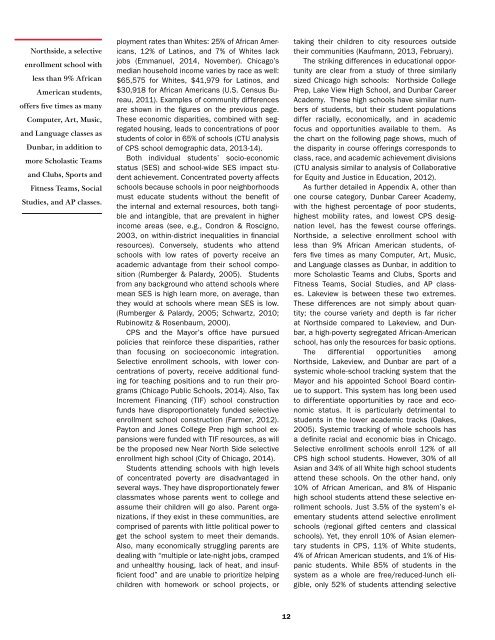A Just Chicago
A_Just_Chicago
A_Just_Chicago
Create successful ePaper yourself
Turn your PDF publications into a flip-book with our unique Google optimized e-Paper software.
Northside, a selective<br />
enrollment school with<br />
less than 9% African<br />
American students,<br />
offers five times as many<br />
Computer, Art, Music,<br />
and Language classes as<br />
Dunbar, in addition to<br />
more Scholastic Teams<br />
and Clubs, Sports and<br />
Fitness Teams, Social<br />
Studies, and AP classes.<br />
ployment rates than Whites: 25% of African Americans,<br />
12% of Latinos, and 7% of Whites lack<br />
jobs (Emmanuel, 2014, November). <strong>Chicago</strong>’s<br />
median household income varies by race as well:<br />
$65,575 for Whites, $41,979 for Latinos, and<br />
$30,918 for African Americans (U.S. Census Bureau,<br />
2011). Examples of community differences<br />
are shown in the figures on the previous page.<br />
These economic disparities, combined with segregated<br />
housing, leads to concentrations of poor<br />
students of color in 65% of schools (CTU analysis<br />
of CPS school demographic data, 2013-14).<br />
Both individual students’ socio-economic<br />
status (SES) and school-wide SES impact student<br />
achievement. Concentrated poverty affects<br />
schools because schools in poor neighborhoods<br />
must educate students without the benefit of<br />
the internal and external resources, both tangible<br />
and intangible, that are prevalent in higher<br />
income areas (see, e.g., Condron & Roscigno,<br />
2003, on within-district inequalities in financial<br />
resources). Conversely, students who attend<br />
schools with low rates of poverty receive an<br />
academic advantage from their school composition<br />
(Rumberger & Palardy, 2005). Students<br />
from any background who attend schools where<br />
mean SES is high learn more, on average, than<br />
they would at schools where mean SES is low.<br />
(Rumberger & Palardy, 2005; Schwartz, 2010;<br />
Rubinowitz & Rosenbaum, 2000).<br />
CPS and the Mayor’s office have pursued<br />
policies that reinforce these disparities, rather<br />
than focusing on socioeconomic integration.<br />
Selective enrollment schools, with lower concentrations<br />
of poverty, receive additional funding<br />
for teaching positions and to run their programs<br />
(<strong>Chicago</strong> Public Schools, 2014). Also, Tax<br />
Increment Financing (TIF) school construction<br />
funds have disproportionately funded selective<br />
enrollment school construction (Farmer, 2012).<br />
Payton and Jones College Prep high school expansions<br />
were funded with TIF resources, as will<br />
be the proposed new Near North Side selective<br />
enrollment high school (City of <strong>Chicago</strong>, 2014).<br />
Students attending schools with high levels<br />
of concentrated poverty are disadvantaged in<br />
several ways. They have disproportionately fewer<br />
classmates whose parents went to college and<br />
assume their children will go also. Parent organizations,<br />
if they exist in these communities, are<br />
comprised of parents with little political power to<br />
get the school system to meet their demands.<br />
Also, many economically struggling parents are<br />
dealing with “multiple or late-night jobs, cramped<br />
and unhealthy housing, lack of heat, and insufficient<br />
food” and are unable to prioritize helping<br />
children with homework or school projects, or<br />
taking their children to city resources outside<br />
their communities (Kaufmann, 2013, February).<br />
The striking differences in educational opportunity<br />
are clear from a study of three similarly<br />
sized <strong>Chicago</strong> high schools: Northside College<br />
Prep, Lake View High School, and Dunbar Career<br />
Academy. These high schools have similar numbers<br />
of students, but their student populations<br />
differ racially, economically, and in academic<br />
focus and opportunities available to them. As<br />
the chart on the following page shows, much of<br />
the disparity in course offerings corresponds to<br />
class, race, and academic achievement divisions<br />
(CTU analysis similar to analysis of Collaborative<br />
for Equity and <strong>Just</strong>ice in Education, 2012).<br />
As further detailed in Appendix A, other than<br />
one course category, Dunbar Career Academy,<br />
with the highest percentage of poor students,<br />
highest mobility rates, and lowest CPS designation<br />
level, has the fewest course offerings.<br />
Northside, a selective enrollment school with<br />
less than 9% African American students, offers<br />
five times as many Computer, Art, Music,<br />
and Language classes as Dunbar, in addition to<br />
more Scholastic Teams and Clubs, Sports and<br />
Fitness Teams, Social Studies, and AP classes.<br />
Lakeview is between these two extremes.<br />
These differences are not simply about quantity;<br />
the course variety and depth is far richer<br />
at Northside compared to Lakeview, and Dunbar,<br />
a high-poverty segregated African-American<br />
school, has only the resources for basic options.<br />
The differential opportunities among<br />
Northside, Lakeview, and Dunbar are part of a<br />
systemic whole-school tracking system that the<br />
Mayor and his appointed School Board continue<br />
to support. This system has long been used<br />
to differentiate opportunities by race and economic<br />
status. It is particularly detrimental to<br />
students in the lower academic tracks (Oakes,<br />
2005). Systemic tracking of whole schools has<br />
a definite racial and economic bias in <strong>Chicago</strong>.<br />
Selective enrollment schools enroll 12% of all<br />
CPS high school students. However, 30% of all<br />
Asian and 34% of all White high school students<br />
attend these schools. On the other hand, only<br />
10% of African American, and 8% of Hispanic<br />
high school students attend these selective enrollment<br />
schools. <strong>Just</strong> 3.5% of the system’s elementary<br />
students attend selective enrollment<br />
schools (regional gifted centers and classical<br />
schools). Yet, they enroll 10% of Asian elementary<br />
students in CPS, 11% of White students,<br />
4% of African American students, and 1% of Hispanic<br />
students. While 85% of students in the<br />
system as a whole are free/reduced-lunch eligible,<br />
only 52% of students attending selective<br />
12


